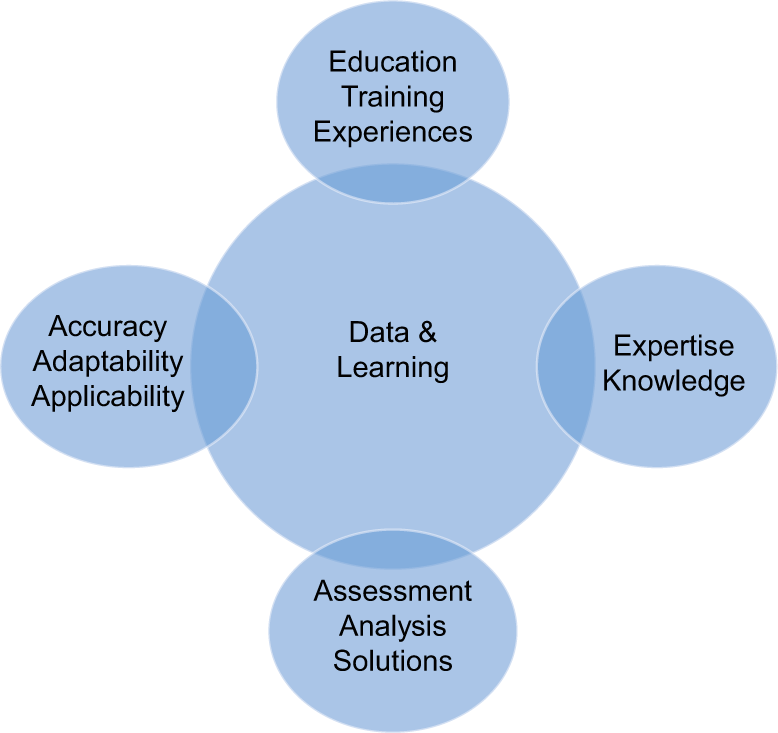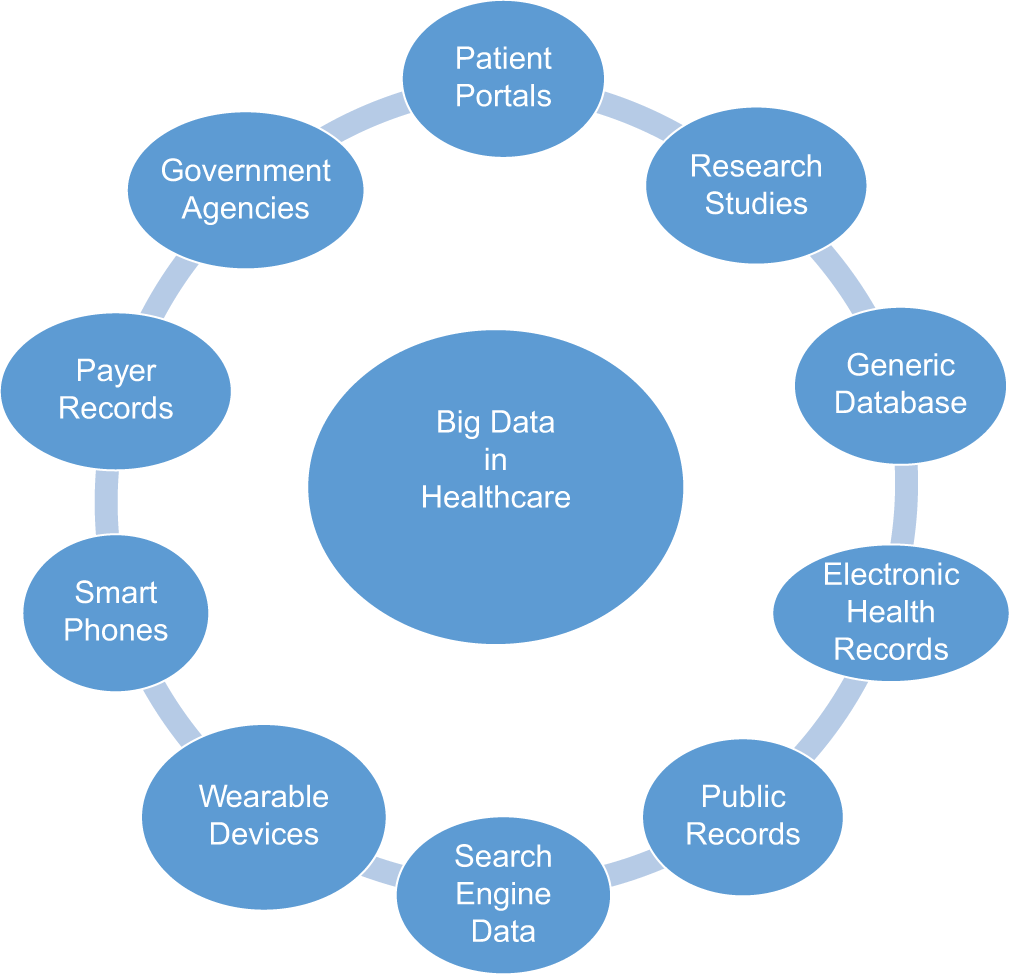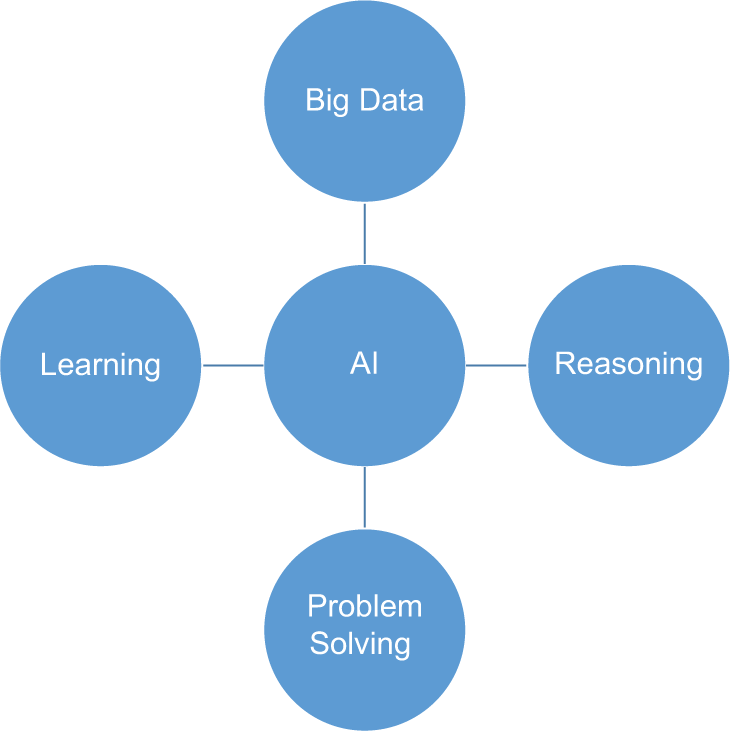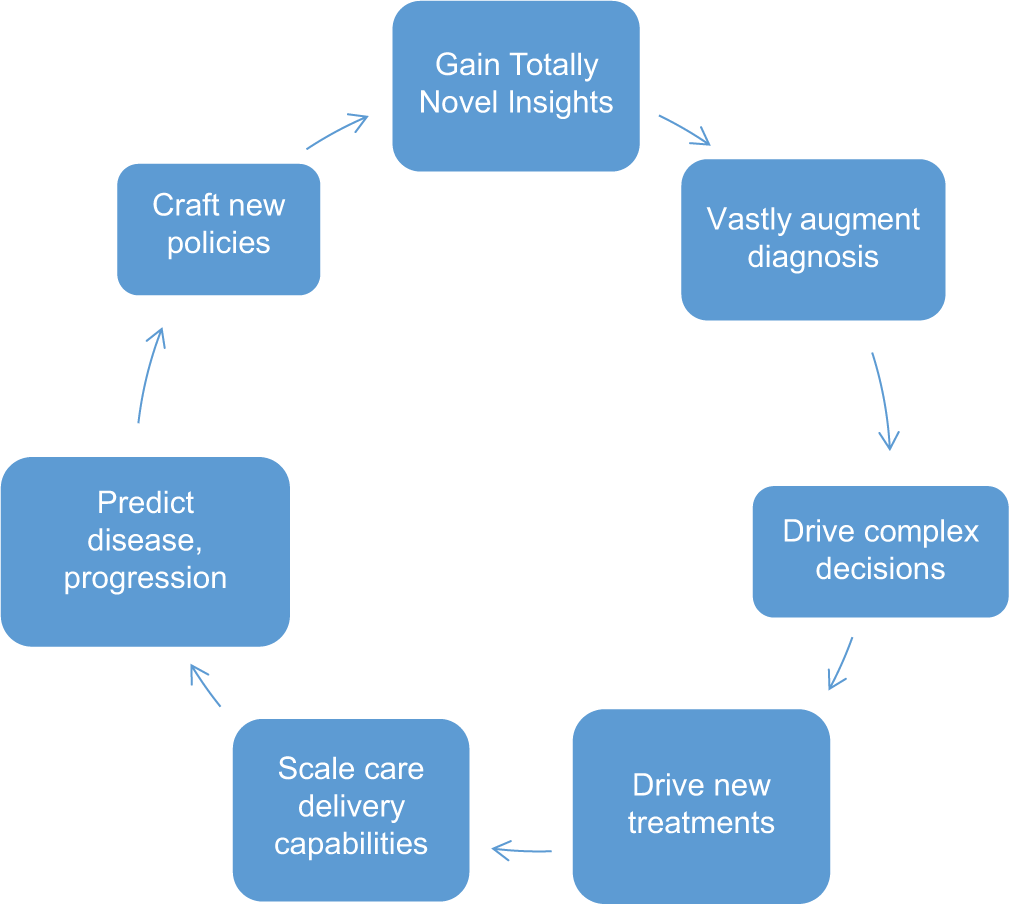Translate this page into:
Artificial intelligence and big data in healthcare

*Corresponding author: Ragukumar Venugopal, Clinical Optometrist, Research Associate, Department of eyeSmart EMR & AEye, IHOPE, LV Prasad Eye Institue, Hyderabad - 34, Telangana, India. ragu.kumar@lvpei.org
-
Received: ,
Accepted: ,
How to cite this article: Venugopal R. Artificial intelligence and big data in healthcare. IHOPE J Ophthalmol 2023;2:49-53.
Introduction: Artificial intelligence (AI) is the capability of a computer program to perform tasks or reasoning processes that we usually associate with intelligence in a human being.[1] In many ways, we are building AI systems to mirror the evolution of the human brain as learning; the most extensive power of human beings is the ability to imagine the datasets. Interestingly, AI and intelligence systems are moving through creating new solutions.[2]
The first and foremost thing of the data and data sets is to learn, explore and experience. It can be either from a book or an educational system and training the data becomes part of the first evolution to an expert system.[3] Still, it happens in gaining expertise and knowledge, that is, by building an intelligence platform. Furthermore, humans can widen their knowledge in learning, solving, analyzing, and assessing things. They build capabilities in the final stage that can become accurate, understand the context, and adapt to change the situation.[4] An overview of data and learning represented in [Figure 1].

- How humans evolve in the data and learning process.
Big data in healthcare – More data, better data, and more connected data: Big data in healthcare are vast data extracted from multiple sources, directly connected to healthcare delivery, and indirectly related to healthcare. Patient search records are extracted through numerous sources such as electronic medical records (EMR) and a direct X-ray image of what happens in the buying pattern with the credit card; all of these can be brought down to figure out the health data. We can go very deep and look for patients’ genomics, laboratory reports, pharmaceutical research, payor records, and medical devices; also, we can look at the patient’s behavior patterns and the patient travel history of all of these results in the health data.[4,5] Hence, data connected to health are the fastest-growing data source globally.[6] A recent article published in internal medicine shows the components and the annual growth rate as we move out to 2025.[7] One day health-care technology will touch all of us; it is a statement method, and it is true. This tremendous urging data are basic information related to a specific set or domain of an issue that touches a patient’s care; that is what we are concerned about. There are six fundamental features of big data. Distribution of Big data in health care presented in [Figure 2].[8]

- Various sources of healthcare big data and the promise of value-based care.
Volume – The amount of data from myriad sources: Volume is an obvious feature of big data and is mainly about the relationship between size and processing capacity. Healthcare is exponentially increasing as the data comes from many sources.[8]
Variety – Types of data: It describes the wide variety of data that are being stored and still need to be processed and analyzed.
Structured data: Data whose elements are addressable for effective analysis. These data are most processed in the development and simplest way to manage information. It categorizes and is known as lab and app-based data from the sources.
Unstructured data: EMR contains a considerable amount of unstructured data, such as progress notes. The complexities of unstructured data and existing text mining tools and natural language processing applications have limited accuracy in extracting information from free text. Unstructured data limit the application of automated computational phenotyping methods and increase the likelihood of low data quality (e.g. missing data).[9]
Semi-structured data: It has the components of both speed of data (Tera byte of data generated every day) in the health-care space alone, and as we expand the ability to connect and collect by the sensor, which is log function changes and exponential changes.[8]
Velocity: It measures the temporary value of data. Velocity involves the condition that we need to process our data quicker to get the results.[8]
Veracity: It shows the quality and origin of data.
It allows it to be considered questionable, conflicting, or impure and provides information about data. Everything belonging to the company’s core process is reliable, but the rest of the data is contaminated; we must consider this wrong data and be convinced that the selected data will also work properly and be sufficient.[8]
Value: It describes how the stored big data gets better results.
Variability: The way how to be the big data can be used or formatted.
It shows to what extent and how fast the structure of our data changes.[8] On the other hand, we are getting lots of stuff from multiple sources, driving an ocean of data and noise, and the combination makes it hard to say what we can do with the data and how we can understand, that is, the data environment. However, data are useless unless you know to capture, manage, and analyze it; AI makes information intelligent and simplistic. Even if we collect a small data set: if we mine and use it, it can be potent; it has a lot more value.
AI: “Artificial intelligence is the science of making machines do things that would require intelligence if done by man.”[10]
It is trying to make machines with the intelligence to make decisions that can augment human capabilities, but this is where humans and machine interactions become complicated issues, and this is going to be the evolution of technology and the dynamics between labor and technology.
Big data – Capable of processing massive amounts of structured and unstructured data, which can change constantly. Reasoning – The ability to differentiate makes reasoning one of the essential components of AI.
The reason is to allow the platform to draw inferences that fit with the provided situation. Further, these inferences are also categorized as either deductive or inductive, and reasoning always involves drawing relevant interferences based on a situation. Problem-solving – The AI problem-solving ability comprises data, and AI witnesses a considerable variety of problems being addressed in the platform. The different method of problem-solving divides the queries into special and general purposes. The component in AI allows the programs to include step-by-step reduction of difference, given between any goal state and current state. Learning – The learning components of AI include memorizing individual items such as different solutions to problems, vocabulary, foreign languages, historical patterns, expert input, and feedback loop. This learning method is later implemented using the generalization method. AI will take big data; it can reason, it can solve problems, can remember, and can prognosticate what is going to happen. [Figure 3] Shows the components of AI.[11]

- The components of artificial intelligence.
Big data-driven ai new frontier in healthcare: We can gain novel insights and vastly augment diagnosis, which is essential because one of the world’s biggest challenges today is a lack of adequately trained health-care professionals. Vastly extended diagnosis can drive complex decisions because the data sets are so complex that humans cannot compute at that level of complexity.[3] They can synthesize human interactions, make the final decision, and drive new treatments. Drug discovery today cannot happen unless we have an extensive data-driven intelligence system. One of the biggest challenges in healthcare is that we are bricks and motors fixated that do not have the physical ability to scale, and we have shortages of professionals; this creates the need to develop and scale the care delivery capabilities. This will enable us to predict disease and progression and prognosticate what can happen, especially the things that affect society, with a high degree of accuracy.[12] Finally, crafting new policies is changing how we do clinical care in ways that were never possible.[13] [Figure 4] Represents the Cycle of AI and big data useful in health care.

- How the big data-driven artificial intelligence is useful in healthcare.
The AI spectrum: Human-driven decisions: AI is the computerized ability to perform tasks commonly associated with human intelligence, including reasoning, discovering patterns and meaning, and generalizing knowledge. We develop protocols and always have rule-based ones as we go to more complex choices. Like a logic tree or decision tree, it is a form of intelligence because whatever we are doing, we are going through rules based on learning.
In statistics, we see algorithms, a lot of what we see as nonadaptive; AI is not only a deep learning system, it is an intelligent system, and they are all statistically sound systems. A statistical test and application on research projects, scaling it up to a whole community or country, becomes a powerful tool. We can get great insights and then reach a more complex intelligent system, a hybrid; there are called decision trees, forest trees, complex, and multivariates, yet they are not autonomous learning systems. Independent learning systems are neural networks and mathematical algorithms built around our understanding of cognitive psychology and neural processing, the brain is an amazing organ, and as neurosciences progress, these models have evolved. Hence, they become adaptive neural networks, autonomous neural networks, and self-learning neural networks.
The learning system, the way it works, is a neural network that we develop and structure it. The network forms are already focused on the ones called convoluted net because it is more applicable to image analysis. It is more relevant to medicine and ophthalmology; this is the network system in that we have a training data set, and it learns features of what we want to teach. Based on how it learns, it changes its neural connection and mathematically changes the way different notes interact. They are getting functions, so these functions allow a particular set of notes to fire at a great rate. Therefore, it picks up features, learns, and then gives us raw data to figure things out.
They diagnose a new condition and develop a new solution for the things that do not exist; there is a network that extends completely new based on the information of living things that they have, called GANS – Generative competitive and self-organizing networks. It is really interesting to see the third-generation of a neural network system.
A convoluted network is extremely good at image processing and making the diagnosis. It looks at a small field of view at the different components of the images (i.e.) convolution scan across the first layer of analysis. If you do multiple scans, we will get multiple layers of analysis, and these are all called convolution, and we will start to pool them together. It gets pooled together, so a more prosperous scan at every set or every image assessment will add to multiple convolution and pooling. We get a much richer feature set connected across all the neurons, and the output evaluates the picture.
Conclusion: Big data and AI can bring health equity by enhancing the quality of care, improving access to care, addressing professional staff shortages, enhancing knowledge and skills, improving the economics of care, lower costs; through this; we can get a more equitable changing system for our citizens.
Acknowledgment
We would like to acknowledge Dr. Mehul Mehta, a Chief Medical Officer from the Albright Stonebridge group, for his insightful thoughts on this topic and presentation at the conference; Dr. R Kim, Chief Medical Officer, Senior Medical Consultant, Retina and Vitreous Services, Director, Information Technology and Systems, Aravind Eye Hospital, Madurai, Prof. Madhu Viswanathan Associate Professor of Marketing for their keen thoughts about the AI and big data in Ophthalmology in the panel discussion of IHOPE 2022 conference along with Dr. Anthony Vipin Das, Co-Principal Investigator, IHOPE and Dr. Kriti Shukla, Research associate, IHOPE.
Declaration of patient consent
Patient’s consent not required as there are no patients in this study.
Conflicts of interest
There are no conflicts of interest.
Financial support and sponsorship
Nil.
References
- Artificial Intelligence: Potential Benefits and Ethical Considerations Strasbourg, France: European Parliament; 2016.
- [Google Scholar]
- Applicability of artificial intelligence in different fields of life. Int J Sci Eng Res. 2013;1:28-35.
- [Google Scholar]
- The magic of three-dimensional printing in ophthalmology. Kerala J Ophthalmol. 2018;30:209-15.
- [CrossRef] [Google Scholar]
- Key capabilities of an electronic health record system: Letter report In: Patient Safety: Achieving a New Standard for Care. United States: National Academies Press; 2004.
- [Google Scholar]
- Interfacing registries with electronic health records In: Registries for Evaluating Patient Outcomes: A User's Guide (3rd ed). United States: Agency for Healthcare Research and Quality; 2014.
- [Google Scholar]
- Looking to tomorrow's healthcare today: A participatory health perspective. Intern Med J. 2018;48:92-6.
- [CrossRef] [PubMed] [Google Scholar]
- Big Data: The 6 VS You Need to Look at for Important Insights Netherlands: Motivaction International; 2018.
- [Google Scholar]
- Extracting information from the text of electronic medical records to improve case detection: A systematic review. J Am Med Inform Assoc. 2016;23:1007-15.
- [CrossRef] [PubMed] [Google Scholar]
- A systematic perspective on the applications of big data analytics in healthcare management. Int J Healthc Manag. 2018;12:226-40.
- [CrossRef] [Google Scholar]
- Transforming Healthcare with AI: The Impact on the Workforce and Organizations. Vol 10. New York: McKinsey and Company; 2020.
- [Google Scholar]





